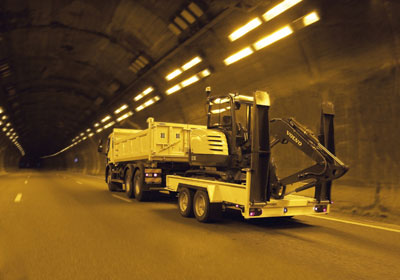Charge of the Light Brigade

Before you even snatch up the bullhorn to marshal your drivers, pick up your trusty calculator to mix and match a few numbers – because trailering is all about numbers. The gross vehicle weight rating (GVWR) of your truck, the GVWR of your trailer, the weight of the trailer and the gross weight of the equipment you want to haul to be exact. Don’t worry, there’s no long division. This task is more like a word problem.
Let’s say there is a 3 1/2-ton dump truck traveling to Long Beach for a utility job. You have a GVWR of about 15,000 lbs, which means you can safely pull up to that weight. If you have a 10,000-lb capacity trailer (a trailer with two axles rated for 5,000 lbs each), just add the trailer’s unloaded weight to that number to get the gross trailer weight (GTW) – that’s how much the trailer will weigh fully loaded. So, if your trailer is 3,000 lbs, then your total towing weight is 13,000 lbs, which is well within the range of a 3 1/2-ton chore truck.
So, no equipment has even come near the trailer and you are already juggling four numbers. You can put aside the truck’s GVWR, as you already figured that it can safely pull a loaded trailer. Now you’re left with the weight of the trailer, the trailer’s GVWR and the GTW. Considering the 10,000-lb trailer weighs 3,000 lbs, you subtract 3,000 from 10,000 lbs and get 7,000 lbs – that’s the total weight of equipment you can trailer.
The 7,000 lbs that is available for towing would cover the weight of a small- to mid-sized skid steer, which typically ranges in operating weights from 2,500 to 9,000 lbs (with the exception of Gehl’s 7810E skid steer monster that sports an operating weight of 10,000 lbs). Depending on the size of your trailer (16-, 18- and 20-ft long are popular lengths), you could potentially load up your unstoppable tag team of skid steer and compact excavator. Compact excavators tend to range between 1,600 to 10,000 lbs in operating weight and 9 to 17 ft in length, while skid steers tend to hover around the 8- to 12-ft range in length. If you’re the proud owner of tiny equipment, then the length of your trailer is the determining factor as to if you can load up your skid steer and mini ex – and remember to consider attachments too.
“When trailering equipment, the most important consideration is safety. The heavier loads will increase your stopping distances. Drivers should always give proper spacing to the vehicles ahead of them. Even before getting on the road, the driver should perform a safety check after hooking up the trailer. This should include checking attachment of the pintel hook, ball or fifth wheel, verify the safety chains are properly hooked up and that the running lights, signal lights and electric brakes are functional,” recommends Brad Pugh, Ram chassis cab product planning manager for Dodge. “The driver should know what the speed rating of the trailer tires is and stay below that speed. The added weight will change the way the vehicle performs. It will accelerate slower, take longer to stop and handle differently when changing lanes.”
Weight continues to play an important role when you’re loading up attachments. Those have weight too you know, and you have to add that weight into your trailering load. Let’s say that you want to unleash a pack of wild compact utility loaders (CULs or mini skid steers); the typical CUL weighs between 1,500 and 2,000 lbs and measures around 5 to 6 ft in length. You could easily load two of those puppies onto an 8,000-lb capacity, 16-ft long trailer (with a weight of 3,000 lbs). But to get the most productivity out of those minis, you’re going to want to take along some attachments.
A hydraulic breaker weighing 200 to 400 lbs and a cement mixing bowl attachment (75 to 500 lbs) for light construction work can easily add an extra 400 to 1,000 lbs. Now your load of two 2,000-lb CULs is up to 5,000 lbs and you are butting up against the 5,000 lbs of total equipment your 8,000-lb trailer can haul. If you want to take along more attachments, you’re going to have to take off one CUL. It’s these types of decisions that small equipment haulers face on a daily basis.
“Aside from numbers, prior to towing a trailer it’s important to ensure that your regular vehicle maintenance schedule is up to date. Other, less obvious items include making sure that your tire pressures are inflated to the stated recommendation. Tire pressure greatly affects vehicle stability and handling. Brake fluid levels should be verified since you’ll be stopping a much heavier load,” says Pugh. “Adding synthetic axle fluid to your rear differential will provide additional protection against gear overheat from the added trailer tow load. To ensure proper break-in for a new vehicle, many folks drive their new trucks at least 500 miles prior to towing. It’s also wise to check all your running lights, turn signals and electric brakes prior to pulling out onto the road.”
If you really want to avoid numbers, many manufacturers from Bobcat and Volvo to Compact Power and Toro offer trailers specifically designed to fit their machines and attachments, so you know what you can carry at all times. Crunching the numbers isn’t fun, and the thought of doing math might send some contractors to find their thinking caps. But 15 minutes of number games can save time and money, allowing you to get to the jobsite safely and quickly.

Comments are closed here.